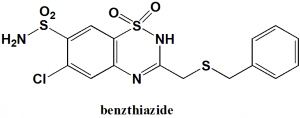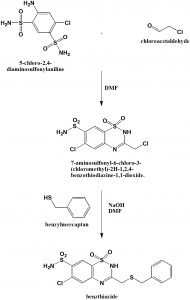BENZTHIAZIDE Synthesis, SAR, MCQ,Structure,Chemical Properties and Therapeutic Uses
Benzthiazide
IUPAC nomenclature
6-chloro-1,1-dioxo-3-(phenylmethylsulfanylmethyl)- 4H-benzo[e][1,2,4]thiadiazine-7-sulfonamide
Classification
- Thiazide diuretic
Physiochemical Properties
| S. NO. | PHYSICAL AND CHEMICAL PROPERTIES | |
| 1 | Molecular weight | 431.9 g/mol |
| 2 | Physical appearance | White crystalline powder |
| 3 | Melting point | 231.5oC |
| 4 | Solubility | Freely soluble in dimethylformamide; practivally insoluble in water |
| 5 | Octanol/water partition coefficient | 1.73 |
| 5 | Presence of ring | Benzothiazine |
| 6 | Number of chiral centers | Not present |
Mechanism of Action
- Benzthiazide prevents active chloride reabsorption at the early distal tubule through the sodium chloride contransportor which results in an increase in the excretion of sodium, chloride and water from the body.
- The drug also binds with thiazide-sensitive Na-Cl transportor and prevents sodium ion transport across the renal tubular epithelium. This increases the potassium excretion through Na-K exchange mechanism.
- It can also mediate its actions on carbonic anhydrase in the smooth muscle or on the large-conductance KCa channel found in smooth muscle.
Structure Activity Relationship
General structure activity of thiazide diuretics can be summarized as:
- Chlorothiazide is the simplest member of the series.
- Hydrogen atom at the 2-N is most acidic due to presence of electron-withdrawing group.
- Sulfonamide group at C-7 position provides additional acidity to the drug.
- Electron withdrawing group is essential at position 6 for diuretic activity of the drug.
- Substitution oh hydrogen at 6 position gives little diuretic activity, whereas, substitution with chloro and trifluoromethyl groups gives highly active compounds.
- Substitution of electron donating group at position 6 significantly reduces the diuretic activity.
- Replacement or removal of sulfonamide groups from position 7 significantly reduces the diuretic activity.
- Saturation of the double bond to give 2,4-dihydro derivative are 10-folds more active than the unsaturated compounds.
- Substitution of a lipophillic group at 3 position increases the potency.
- Substitution with the entities such as haloalkyl, aralkyl or thioether gives compounds with longer duration of action due to increased lipid solubility.
- Alkyl substitution at the 2-N position can increase the action duration. [1]
Method of synthesis
i. 5-chloro-2,4-diamino-sulfonylaniline reacts with chloroacetaldehyde in presence of dimethylformamide as solvent to give 7-aminosulfonyl-6-chloro-3-(chloromethyl)-2H-1,2,4-benzothiodiazine-1,1-dioxide.
ii. The above formed compound is reacted with benzyl mercaptan in presence of sodium hydroxide and dimethylformamide as a solvent to produce benzthiazide. [2]
Medicinal Uses
Benzthiazide is used for:
- Treatment of high blood pressure
- Management of edema related to heart failure
Side Effects
Side effects of benzthiazide are:
- Hyperuricemia
- Hypophosphatemia
- Low magnesium level in serum
- Hypokalemia
- Alkalosis
- Hyponatremia
- Hypercalcemia
- Orthostatic hypotension
- Nausea
- Vomiting
- Diarrhea
- Gastric irritation
- Anorexia
- Dizziness
- Restlessness
- Headache
MCQs
Q.1 “6-chloro-1,1-dioxo-3-(phenylmethylsulfanylmethyl)- 4H-benzo[e][1,2,4]thiadiazine-7-sulfonamide” is the IUPAC nomenclature of which drug?
a) Procyclidine
b) Benzthiazine
c) Amyl Nitrate
d) Bleomycin
Q.2 Melting point of drug Benzthiazide is?
a) 140.5 oC
b) 231.5 oC
c) 100 oC
d) 342 oC
Q.3 Match the following with correct classifications of the drugs.
| i. Benzthiazide | A. Inhalational anesthetics |
| ii. Pralidoxime | B. Cholinestrase reactivator |
| iii. Propranolol | C. ß-adrenergic blocker |
| iv. Isoflurane | D. Thiazide diuretics |
a) i-C, ii-A, iii-D, iv-B
b) i-D, ii-C, iii-A, iv-B
c) i-D, ii-B, iii-C, iv-A
d) i-C, ii-D, iii-B, iv-A
Q.4 Mechanism of action of the drug Benzthiazide includes?
I. The drug releases NO after denitration reaction.
II. Binding with thiazide-sensitive Na-Cl transportor
III. Prevents sodium ion transport across the renal tubular epithelium
a) I, II, III
b) II, III
c) I, III
d) I, II
Q.5 Correct sequence for True and False for the given statements related with the SAR of Thiazide diuretics can be?
- Chlorothiazide is the simplest member of the series.
- Hydrogen atom at the 2-N is most acidic due to presence of electron-withdrawing group.
- Sulfonamide group at C-7 position provides additional acidity to the drug.
a) TFF
b) FFT
c) TTT
d) FFF
Q.6 Number of chiral carbons present in the structure of benzthiazide is?
a) 0
b) 1
c) 2
d) 3
Q.7 The drug benzthiazide is mainly used for?
a) Treatment of Hypertension
b) As an anesthetic
c) Treatment of Alzheimer’s disease
d) Treatment of Parkinson disease
Participate in Online FREE GPAT TEST: CLICK HERE
Participate in Online FREE Pharmacist TEST: CLICK HERE
Participate in Online FREE Drug Inspector TEST: CLICK HERE
Participate in CSIR NET JRF Mock Test
ANSWERS
1-b
2-b
3-c
4-b
5-c
6-a
7-a
REFERENCES
[1] Lemke TL, Williams DA, editors. Foye’s principles of medicinal chemistry. Lippincott Williams & Wilkins; 2012 Jan 24.
[2] US 3 111 517 (Pfizer; 19.11.1963).

